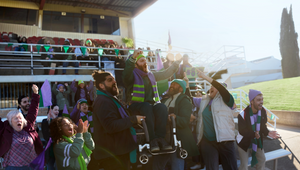
Save the Children Uses Fictional Language to Spotlight War-Affected Children's Trauma

Nearly one in five children worldwide is growing up in the shadow of war -- a figure that has almost doubled in the past 30 years. With new research revealing that 87% of Australians feel deeply for children affected by conflict, Save the Children Australia is launching 'Every Child, Every Conflict' -- a powerful new short film that transcends borders, politics and language to highlight the universal suffering of children caught in war.
Produced by Ando Films, 'Every Child, Every Conflict' presents a dramatic, powerful moment in the lives of two children in a fictional conflict zone. The story is told entirely in “Bajasá,” an invented language created to symbolise the shared trauma experienced by children in war, regardless of where they live or the language they speak.
Inspired by Save The Children founder Eglantyne Jebb's words that ‘the only international language in the world is a child's cry,’ the fictional language was designed by renowned Linguist Jacob Newbegin. Bajasá, was created to bypass preconceptions, politics, religion and alignments to specific regions and nations – symbolising the universal nature of suffering children endure in war, regardless of where they live or the language they speak.
Save the Children Australia CEO, Mat Tinkler said, “'Every Child, Every Conflict' illustrates in haunting accuracy the reality of life for these children. From Gaza to Sudan, Ukraine to Syria, Myanmar to Afghanistan, the suffering of children in conflict is universal. Pain, fear, and loss transcend borders, beliefs, and translation."
The release of the film comes as 2023 is confirmed as the worst year on record for verified grave violations against children in war zones, including killings, abductions, sexual violence, and attacks on schools and hospitals.
“The plight of children in war zones is top of mind for Australians," Mat said. "Now is the time to redouble our efforts to protect and promote all of these children who are having their youth and futures stolen by war."
The linguistics team spent six months developing the unique structure of the language, specifically engineered to convey trauma, hope, and resilience in ways that transcend cultural boundaries.
Director, Brian Patto said, “Language can be both a bridge and a barrier. From the beginning, I knew I didn't want a dialogue that anchored the film to a specific place, nationality or political context. So we created a language, one that wasn't designed to be necessarily translated, but carried emotional weight.
"The goal wasn't comprehension; the goal was connection. And that was always the point: this could be any child anywhere in the world speaking any language -- that idea shaped every storytelling aspect. It shaped the decision of the filmmaking process, from the cinematography to the pacing, to the performance.”
Lead linguist, Jacob Newbegin explained, " When children are traumatised, they change the way they communicate. We wanted to give them a voice that belonged only to them, so every sound, every syllable was crafted to carry their emotions without the politics and prejudice that can comes with existing languages.
“The prospect of contributing to this project was, to me, not only an opportunity to help illustrate the importance of language but the protection of those who speak it.”












